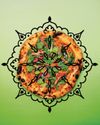DO NO HARM

In the early months of the pandemic, joggers on the Bear Creek Greenway, in southern Oregon, began to notice tents cropping up by the path. The Greenway, which connects towns and parks along a tributary of the Rogue River, was beloved for its wetlands and for stands of oaks that attracted migrating birds. Now, as jobs disappeared and services for the poor shut down, it was increasingly a last-ditch place to live. Tents accumulated in messy clusters, where people sometimes smoked fentanyl, and “the Greenway” became a byword for homelessness and drug use. On a popular local Facebook page, one typical comment read, “Though I feel sorry for some of the people in that situation, most of them are just pigs.” In Medford, the largest city along the trail, police demolished encampments and ticketed people for sleeping rough.
One September evening in Medford, a white cargo van belonging to a nonprofit called Stabbin Wagon parked near the Greenway, between an auto-repair shop and a Wendy’s. For unhoused people across Oregon, cargo vans have become a symbol of help. Some contain primary-care clinics and food pantries. Others, like Stabbin Wagon’s, distribute a more controversial kind of aid: safe supplies for drug users.
Stabbin Wagon’s director, Melissa Jones, pulsed with nervous energy, and wore flip-flops and a T-shirt that read “Nothing ends homelessness like housing.” With her was Samantha Strong, a young activist with a green buzz cut and piercings. The two women—Stabbin Wagon’s only employees—opened the van’s doors to reveal plastic bins and hanging compartments of inventory, neatly arranged and all free. There were boxes of naloxone, needles of various gauges, cookers, pipes, fentanyl test strips, soap, and hand sanitizer.
This story is from the January 22, 2024 edition of The New Yorker.
Start your 7-day Magzter GOLD free trial to access thousands of curated premium stories, and 9,000+ magazines and newspapers.
Already a subscriber ? Sign In
This story is from the January 22, 2024 edition of The New Yorker.
Start your 7-day Magzter GOLD free trial to access thousands of curated premium stories, and 9,000+ magazines and newspapers.
Already a subscriber? Sign In

Hatagaya Lore Bryan Washington
We moved to Tokyo from Dallas because of my husband's job, an unexplainable tech gig.

A MATTER OF FACTS
On the loss of two sons.

OPEN SECRET
Why did police let one of America's most prolific predators get away for so long?

BEYOND THE CURVE
In medicine and public health, we cling to universal benchmarks—at a cost.

Richard Brody on Pauline Kael's "Notes on Heart and Mind"
When Pauline Kael joined The New Yorker’s staff as a movie critic, in January, 1968, the world of cinema was undergoing drastic change.

CHORAL HISTORY
“The Alto Knights.”

THE ELEMENTS OF STYLE, 2025
Reliable news coverage has never been more important than it is now. Journalists must remain vigilant and rigorous in the face of a second Trump Administration. To help them do so, we are releasing an updated version of Strunk and White’s “Elements of Style.” Please refer to the following examples when writing and reporting, for as long as that’s still allowed.

CHARACTER STUDIES
“Purpose” on Broadway and “Vanya” downtown.

DO YOU KNOW JESUS?
Why the Gospel stories won’t stay dead and buried.

HOME SLICE
The making of an Indian American specialty.
